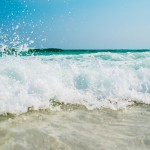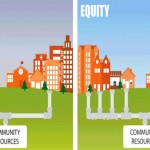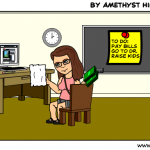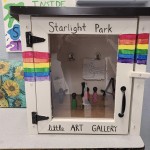Thunk, wobble, crash! A beloved piece of pottery has just been bumped, knocked over, and shattered on the floor. The broken pieces are scattered and the thought of repair is a fleeting hope. Is it even possible to reassemble the pieces? If it can be repaired, won’t its cracks still be visible? Its beauty gone forever? Before this week I would have thought—Yes. Now I know there is a way to not just reform the piece, but add to its beauty and value, making it more interesting and durable than before.
The Japanese art of Kintsugi is a centuries-old technique of repairing broken pottery with gold. Attempts aren’t made to hide the cracks, but to highlight them. Broken pieces are joined and reinforced with gold so that the object is strengthened and beautified.
Kintsugi is a new concept for me. I just learned about it while visiting St. George, Utah over Fall Break. I went to an art show featuring paintings by Kirsten Beitler. In one of her pieces, she painted a representation of her “broken family” being healed through Kintsugi. I was mesmerized by her painting and her ability to express a vulnerable experience with poignancy, dignity, and pride. I haven’t been able to stop thinking about it and the implications of the metaphor on my teaching practice.
I have personally struggled with perfectionism all my life (though it has only been recently that I have started using that label to define it). The metaphor of Kintsugi helps me see that the mistakes I’ve made have made me a stronger teacher. For example, when I overlook a small detail and then see a preventable negative outcome, I learn to notice the little things. When I rush through a conversation to avoid discomfort but then see how strong relationships make my work easier, I take the time to be fully present in every conversation. These are some ways I have found that I am made stronger by my faults.
Another way to apply the metaphor of Kintsugi is to rethink how we view “damaged” students. As teachers who like to stay on top of current research, many of us have learned about trauma-informed teaching, culturally relevant pedagogy, and restorative practices. These are mindsets that allow us to better understand the struggle that many students face at school. But if we’re not careful, we can allow deficit thinking to make us see our students as broken and ourselves as the fixers, shaping them into what we think they should become. Rather, we can take a broad view of the broken systems that have historically marginalized students of color, linguistically diverse students, and LGBTQ students. Our broken education system has limited children’s ability to shape their own lives and outcomes. By using each of these mindsets as tools, however, we can guide children to become creators of their own lives and futures. This will allow us to truly see the “whole child.”
Arizona teachers have had an increasing awareness of the needs of marginalized students for some time now. This increased awareness has resulted in many discussions among educators about the problems within our education system. All too often, that’s the end of the story. It’s as if we’re standing over the shattered pottery on the kitchen floor, too overwhelmed to begin picking up the pieces. But those conversations can be a starting point—not the endpoint. Can we work together to repair (and prevent) some of the damage done to our most vulnerable students? Can we not just feel bad for our students, but feel empowered because we have the knowledge, skills, and tools to help create a system of equity? Our goal should not be to try to erase damage or to pretend it doesn’t exist, but to respectfully, intentionally, and courageously explore the faults of our systems and find ways we can join together to create an environment that is more hospitable to our students’ growth.
Teachers know that going through life (and teaching) unbroken is impossible. I have learned that hiding our faults is shame-inducing and debilitating. I’ve also learned that seeking partnerships with other educators and joining together makes me stronger and the work more impactful. When we reflect upon and refine our fault-lines and those of the system, we can find ways to turn them into strengths.
I would love to hear from you!
Have you encountered Kintsugi before? Or, like me, is this your first exposure to the concept?
What are some ways you’ve found to repair a “broken” system?
More on artist, Kirsten Beitler here: http://www.kirstenbeitler.com/my-brush-with-life/upcoming-solo-show-couch-to-canvas
Art Credit:
photo credit: Pomax <a href=”http://www.flickr.com/photos/98392258@N00/16859301360″>kintsugi closeup</a> via <a href=”http://photopin.com”>photopin</a> <a href=”https://creativecommons.org/licenses/by-nc-nd/2.0/”>(license)</a>









